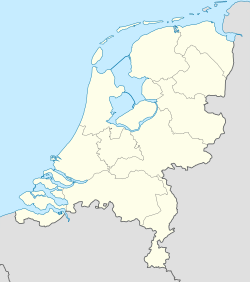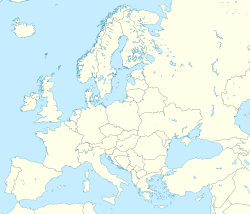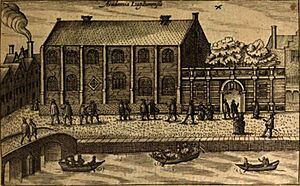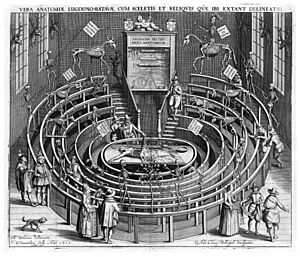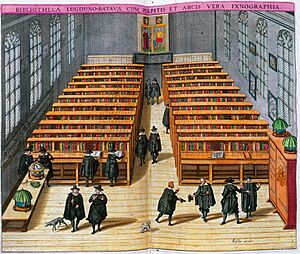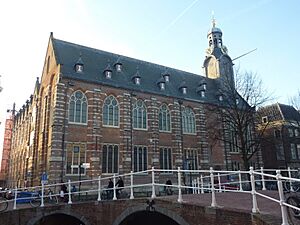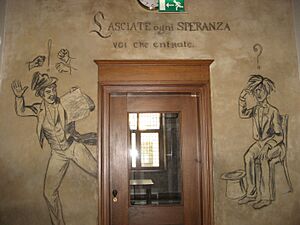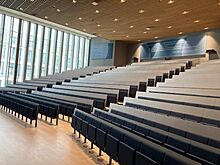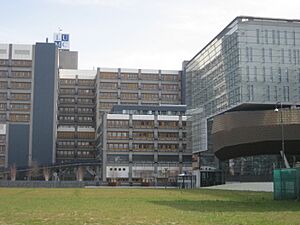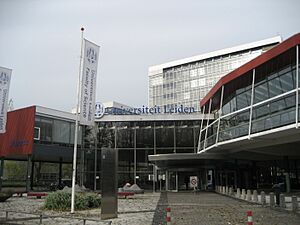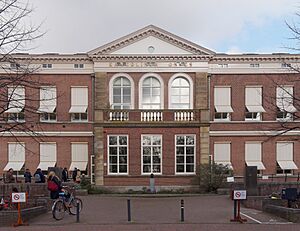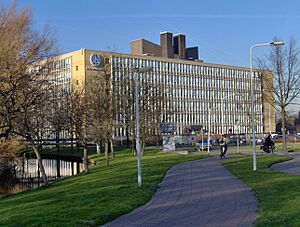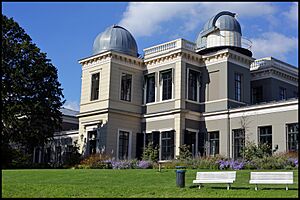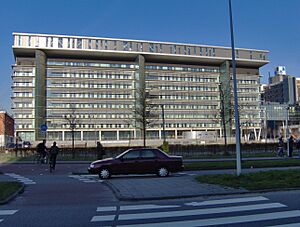Leiden University facts for kids
|
Universiteit Leiden
|
|
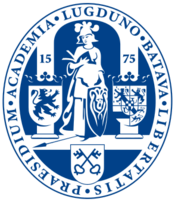 |
|
| Latin: Academia Lugduno-Batava | |
|
Former names
|
Rijksuniversiteit Leiden |
|---|---|
| Motto |
Libertatis Praesidium (Latin)
|
|
Motto in English
|
Bastion of Freedom |
| Type | Public research university |
| Established | 8 February 1575 |
| Founder | William of Orange |
|
Academic affiliation
|
TPC |
| Budget | €777 million (2021) |
| President | Annetje Ottow |
| Rector | Hester Bijl |
|
Academic staff
|
1,862 (2021) |
|
Administrative staff
|
1,573 |
| Students | 37,136 (2021–22) |
| Undergraduates | 24,496 (2021–22) |
| Postgraduates | 12,395 (2021–22) |
| 886 (2021) | |
| Location |
,
,
52°9′25″N 4°29′7″E / 52.15694°N 4.48528°E |
| Campus | Urban and College town |
| Language | Dutch, English (Additional languages for language programmes) |
| Colours | LEI Blue |
| Website | universiteitleiden.nl |
 |
|
Leiden University is a public research university located in Leiden, Netherlands. It was started in 1575 by William, Prince of Orange. It is the oldest university in the Netherlands.
During the Dutch Golden Age, many smart people from all over Europe came to the Netherlands. They liked the freedom to think and share ideas. Famous people like René Descartes (a philosopher), Rembrandt (a painter), and Christiaan Huygens (a scientist) were active in Leiden.
The university has seven main departments and more than fifty smaller ones. It also has over forty research centers. Its main campus is spread across the city of Leiden. There is also a second campus in The Hague. This campus has a special college for arts and sciences. Leiden University is part of important groups of universities in Europe.
Many famous people have studied at Leiden University. This includes twenty-six winners of the Spinoza Prize and sixteen Nobel Prize winners. Members of the Dutch royal family, like Queen Juliana and King Willem-Alexander, went there. Ten prime ministers of the Netherlands, including Mark Rutte, also studied at Leiden. Even a US president, John Quincy Adams, was a student there.
Contents
History of Leiden University
How the University Started
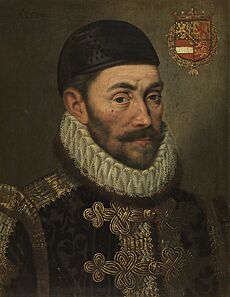
In 1575, the northern part of the Netherlands did not have its own university. The only other university in the area was in Leuven, which was controlled by Spain. Prince William decided to create Leiden University. He wanted to educate people in the northern Netherlands. This would help the government and teach about religion.
It is believed that Leiden was chosen as a reward. The city had bravely defended itself against Spanish attacks in 1574. Even though William was against Philip II of Spain, Philip's name was on the official founding paper. Philip II told his people not to study in Leiden.
The university first started in an old convent. Then it moved to other buildings. In 1581, it moved to a former convent of nuns. The university is still on this site today.
Famous Scholars and Discoveries
Leiden University became famous quickly. Many smart people taught there soon after it opened. These included Justus Lipsius and Joseph Scaliger. By the 1640s, over 500 students from all over Europe were studying there. This made it the largest Protestant university.
Later, in the 18th century, scholars like Herman Boerhaave made the university even more well-known.
In 1896, the Zeeman effect was discovered at the university by Pieter Zeeman. This discovery helped us understand light and magnets better. Soon after, Hendrik Antoon Lorentz explained why it happened.
In 1908, Professor Heike Kamerlingh Onnes did something amazing. He created the world's first low-temperature lab. He reached a temperature just one degree above absolute zero. He was also the first to turn helium into a liquid. He helped discover superconductivity in metals. This is when electricity can flow without any resistance.
Leiden University Today
The University Library is huge. It has over 5.2 million books and fifty thousand journals. It also has many old writings, printed books, photos, and maps. It has the world's largest collections about Indonesia and the Caribbean.
In 2005, a special paper by Albert Einstein was found in one of Leiden's libraries. It was about the quantum theory of gas.
Working with Other Universities
In 2012, Leiden University started working closely with Delft University of Technology and Erasmus University Rotterdam. They wanted to improve their teaching and research. Since 2017, Leiden University has also partnered with Duke University School of Law. They run a summer program together in The Hague.
University Locations and Buildings
Leiden University does not have one main campus. Its buildings are spread out across the city. Some buildings, like the Gravensteen, are very old. Others, like Van Steenis and Lipsius, are quite modern.
The university is connected to several interesting places. These include the Rijksmuseum van Oudheden (National Museum of Antiquities). This museum has amazing collections from Egypt and India. There are also museums about Dutch history and different cultures.
The Hortus Botanicus (botanical garden) is the oldest botanical garden in the Netherlands. It is also one of the oldest in the world. For over 400 years, experts have grown plants from all over the world here. You can see a reconstructed garden from the 1600s. There is also an 18th-century Orangery with large plants. The garden has very old trees and tropical greenhouses.
The "Sweat Room"
The "Sweat Room" (Dutch: Zweetkamertje) is a small room in the university's Academy Building. It has a fun tradition. Students who are about to defend their PhD (doctorate) wait in this room. They are often very nervous, which is why it's called the "Sweat Room."
After they successfully defend their PhD, they get to sign their name on the walls. Many famous people have signed the walls. This includes Winston Churchill, Nelson Mandela, and members of the Dutch royal family. The room is covered with thousands of signatures. In 2014, people helped raise money to fix the walls. This way, this special tradition can continue.
The Hague Campus
In 1998, Leiden University expanded to The Hague. This city is now home to Campus The Hague. Six of the university's seven main departments have a presence there. It is also the only home for the Faculty of Governance and Global Affairs. This faculty focuses on how governments work and global issues. The Hague campus also has Leiden University College The Hague, which is a liberal arts and sciences college.
The university offers courses in law, political science, and public administration in The Hague. It moved into a new building called 'Wijnhaven' in 2016. Since 2017, the Leiden University Medical Center also has a part of its operations in The Hague.
How Leiden University is Organized
The university is split into seven main departments, called faculties. These faculties offer about 50 different bachelor's degree programs. They also have over 100 master's degree programs.
- Archaeology
- Governance and Global Affairs
- Humanities
- Law
- Medicine / LUMC
- Science
- Social and Behavioural sciences
What You Can Study
Bachelor's Degrees
Most of the university's departments offer bachelor's degrees. These degrees are usually a B.A. (Bachelor of Arts), B.Sc. (Bachelor of Science), or LL.B. (Bachelor of Laws).
Master's Degrees
After a bachelor's degree, students can choose from many master's programs. Leiden University offers over 100 master's programs. These lead to degrees like MA (Master of Arts), MSc (Master of Science), or LLM (Master of Laws). Some very advanced programs lead to an MPhil degree. These are for students who want to become professors or researchers.
Doctorate Programs
Many departments also offer doctorate programs. These lead to a Ph.D. degree. This is the highest academic degree. Most Ph.D. programs are part of special research schools or institutes.
Research Centers
Leiden University has over 50 research centers and institutes. Some are part of one faculty. Others work across different faculties or even with other universities.
Rankings and Reputation
| University rankings | |
|---|---|
| Global – Overall | |
| ARWU World | 101-150 (2024) |
| CWUR World | 88 (2025) |
| CWTS World | 72 (2024) |
| QS World | =119 (2026) |
| Reuters World | 71 (2019) |
| THE World | =73 (2025) |
| USNWR Global | 56 (2025-26) |
| Global – Law | |
| QS Law | 25 (2025) |
| THE Law | 21 (2025) |
| Global – Liberal arts | |
| ARWU Social science | 27 (2024) |
| QS Arts & Humanities | =46 (2025) |
| QS Politics | 17 (2025) |
| THE Arts and Humanities | 21 (2025) |
Famous People from Leiden University
Many professors from Leiden University have won the Spinoza Prize. This is the highest science award in the Netherlands. Twenty-eight Leiden professors have received this award. Some of them include:
- Frederik Kortlandt, a linguist (studies languages)
- Ewine van Dishoeck, an astronomer (studies stars and space)
- Wil Roebroeks, an archeologist (studies old human history)
- Naomi Ellemers, a social psychologist (studies how people think and act in groups)
- Eveline Crone, a cognitive psychologist (studies how the brain thinks)
Other important researchers from Leiden include Christiaan Snouck Hurgronje, an expert on Arab and Islam studies. Also, Johan Huizinga, a famous historian.
Nobel Prize Winners
Several people connected to Leiden University have won the Nobel Prize. This is one of the most important awards in the world.
- Heike Kamerlingh Onnes won the Nobel Prize for Physics in 1913.
- Hendrik Antoon Lorentz and Pieter Zeeman won the Nobel Prize for their work on light and electronics.
- Willem Einthoven won for inventing the string galvanometer. This machine helped create the electrocardiogram (ECG), which checks heart health.
Other Nobel Prize winners who were connected to Leiden include famous physicists like Albert Einstein and Enrico Fermi.
See also
 In Spanish: Universidad de Leiden para niños
In Spanish: Universidad de Leiden para niños
- Leiden school
- Leiden University College The Hague
- List of early modern universities in Europe
- List of rectores magnifici of Leiden University


